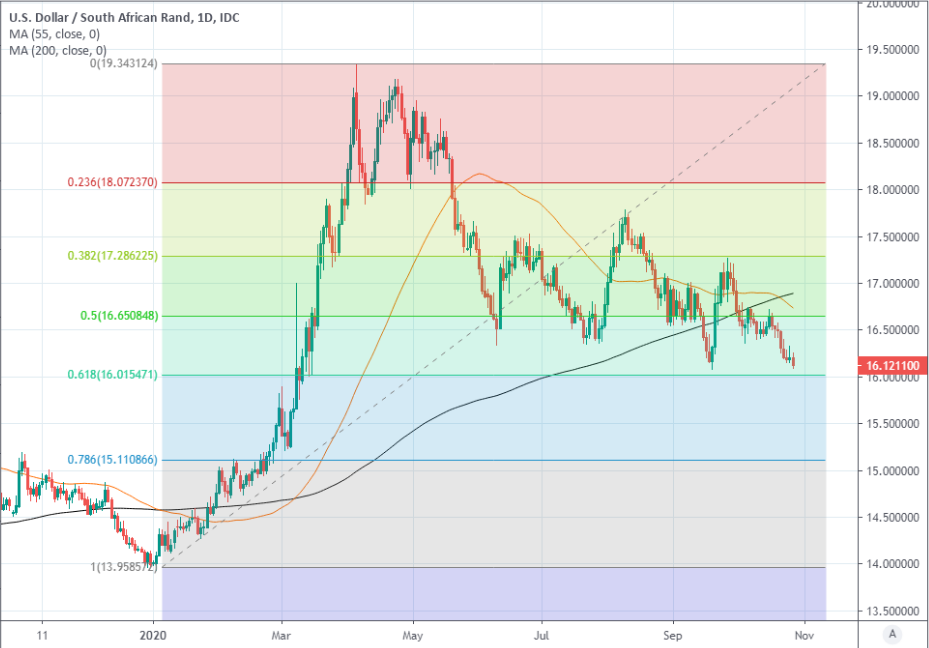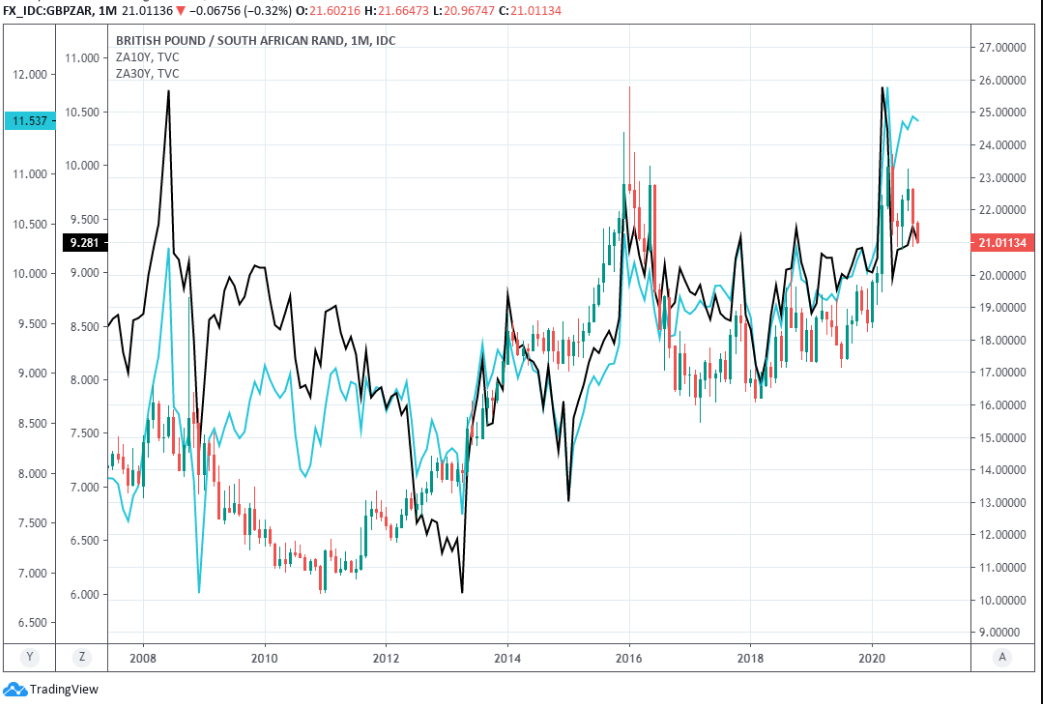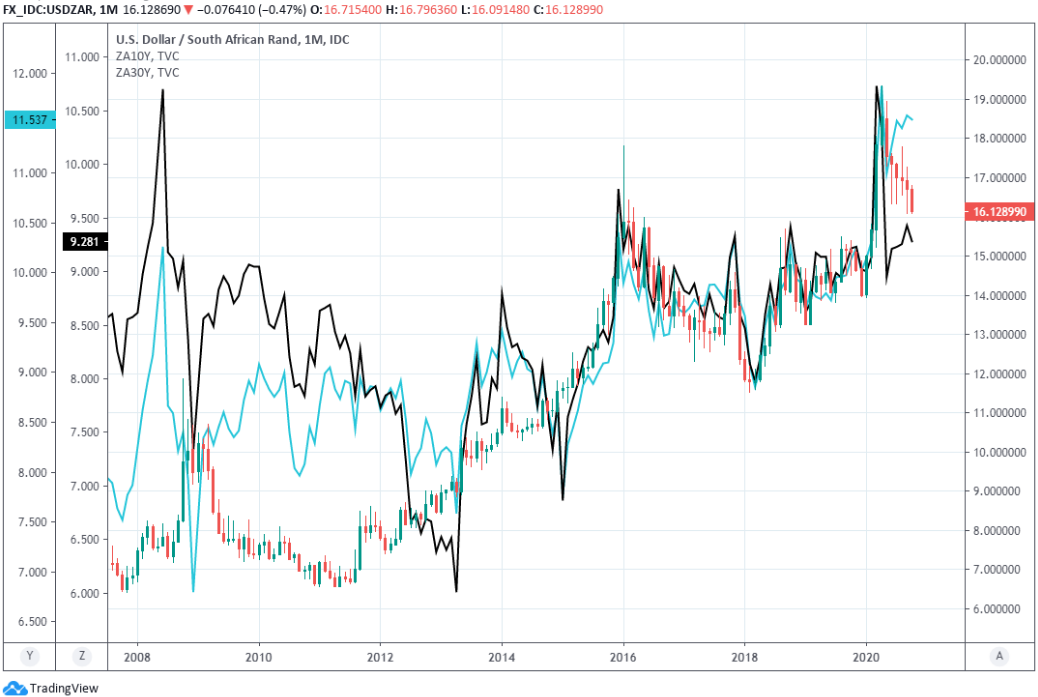South African Rand’s Rally Raises the MTBPS Stakes as USD/ZAR Finds Support on Charts
- Written by: James Skinner
-
- ZAR rally leads into resistance from USD near March highs.
- As 5.7% monthly gain raises MTBPS stakes this Wednesday.
- ZAR reaction hinged on if June’s debt targets remain in place.
- USD/ZAR rallies seen running out of steam at 16.77 & 17.27.

Image © Government of South Africa, reproduced under CC licensing
- GBP/ZAR spot rate at time of writing: 21.01
- Bank transfer rate (indicative guide): 20.28-20.43
- FX specialist providers (indicative guide): 20.70-20.82
- More information on FX specialist rates here
The Rand rallied against almost all major developed and emerging market currencies Tuesday while extending a week-long run against the greenback, but the rally has raised the stakes over Wednesday's budget, which is now even more of a downside risk to the currency.
South Africa’s Rand ceded ground to the Norwegian Krone but was higher against all other major currencies while having swept the board of opposition from emerging world contemporaries after surviving Monday’s softening of risk appetite and the resulting falls in global stock markets.
The Rand had risen more than 5% against the Dollar in the month to Tuesday, taking the South African currency back below 16.10 against the greenback and to its joint highest since mid-September and mid-March, but the greenback has now found support and the Rand collided with resistance on the charts.
“USD/ZAR continues to slide towards the September low at 16.0838. Failure there on a daily chart closing basis would make us short-term bearish and would lead to the September 2018 high at 15.6945 being targeted,” says Axel Rudolph, a senior technical analyst at Commerzbank. “Minor resistance still comes in between the 200- and 55- day moving averages at 16.7720/8936 and at the September high at 17.2718.”
USD/ZAR was below 16.10 Tuesday and testing its September low at 16.08 after weakness in the U.S. Dollar and signs of a faster-than-anticipated South African economic recovery weighed heavily on the exchange rate through summer and into Autumn.
Above: USD/ZAR at daily intervals with Fibonacci retracements (supports) of 2020 rally, 55, 200-day (black) moving-averages.
"Risk sentiment is showing increasing vulnerability as uncertainty builds into next week’s US elections and certain polls suggest a closer race, even if those polls have a distinct political bias. Of equal importance is the persistency in the rise of COVID cases in US as well as Europe and now the added complexity of increasing civil unrest over tightening of social restrictions and faltering of political cohesion in the countries most affected," says Tim Riddell, a London-based strategist at Westpac.
Given the proximity of Wednesday's budget update from Finance Minister Tito Mboweni, it’s not clear the Rand will be able to hold such lofty heights for much longer even if international risk appetite does hold up. The minister will update parliament, the country and markets at 13:00 London time on Wednesday's.
"South Africa’s fiscal problems have been amplified by the crisis, creating the potential for substantial trouble down the line. Unless the government gets its finances under control quickly the world will start demanding higher rand yields as compensation. This has already happened at the long-end of the curve but in a few years’ time we might see short-end rates also having to increase in order to keep foreign capital invested in the country," says John Cairns, a global market strategist at Rand Merchant Bank.
Whether or not USD/ZAR continues lower or reverses up toward its 200-day moving-average at 16.77 could depend greatly on the size of the anticipated increase in debt-to-GDP unveiled by Finance Minister Mboweni this week.
Mboweni set out ambitious targets in June including for South Africa to run a primary budget surplus by 2023/24 and stabilise its debt-to-GDP ratio at 87.4% of GDP that year, despite a budget deficit that was expected to more than double from around 6.8% of GDP in 2019 to over 15% in 2020.
But since June there’s been speculation that South Africa’s debt-to-GDP ratio could rise much higher than 87% in the coming years, potentially taking it above 100% in the absence of corrective revenue raising or spending cuts.
Above: GBP/ZAR at monthly intervals with 10-year (black line, left axis) SA government bond yield and 30-year (blue line).
“Further advances to the R16.00/USD mark are proving too rich for the domestic currency, with the MTBPS looming this week, and a real risk that the ballooning debt projections are not reigned in, escalating further instead, resulting in further marked credit rating downgrades. Indeed, SA could see even two notch downgrades if the debt projections are elevated above the peak of 87.4% of GDP put forward in 24th June supplementary Budget Review,” says Annabel Bishop, chief economist at Investec. “Very rapid debt accumulation is reducing both investors and rating agencies’ perceived view of SA’s creditworthiness, and so elevating bond yields.”
Whether or not Mboweni retains the balanced budget target will be key to the Rand’s trajectory ahead of next weekend, although any sharp increases in Treasury’s debt-to-GDP forecasts would risk rendering this impossible.
South Africa was already stripped of its last remaining ‘investment grade’ credit rating in March, technically pushing it into ‘junk territory’ in a decision that had preemptively weighed on the currency for months beforehand, although the country’s rating can still be cut further from current levels.
A reduced credit rating could incite increases in market financing costs for the government, making current spending levels even less affordable and so demanding even greater spending cuts that could crimp the economy’s recovery out of its coronavirus crater in the coming years.
“Rising credit risk, which is reflective of increased investor concerns of a possible eventual debt default, is resulting in reduced foreign interest, with prices falling as supply balloons,” Bishop says of the government bond market. “While the short end of the yield curve is anchored by low money market rates (the repo rate is at historic lows), the mid to longer-end has risen substantially, and this steepening in the yield curve reflects the widening spreads and perceived deteriorated creditworthiness. Reforms are gathering pace now but not fiscal consolidation. Insufficient reforms have occurred over the past two years to sufficiently boost economic growth and so revenue collection to achieve the active debt scenario, and large cuts in expenditure are critical.”
Above: USD/ZAR at monthly intervals with 10-year (black line, left axis) SA government bond yield and 30-year (blue line).













